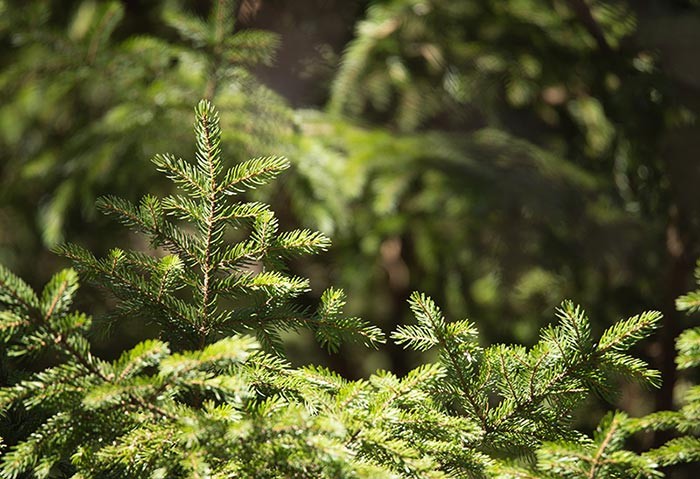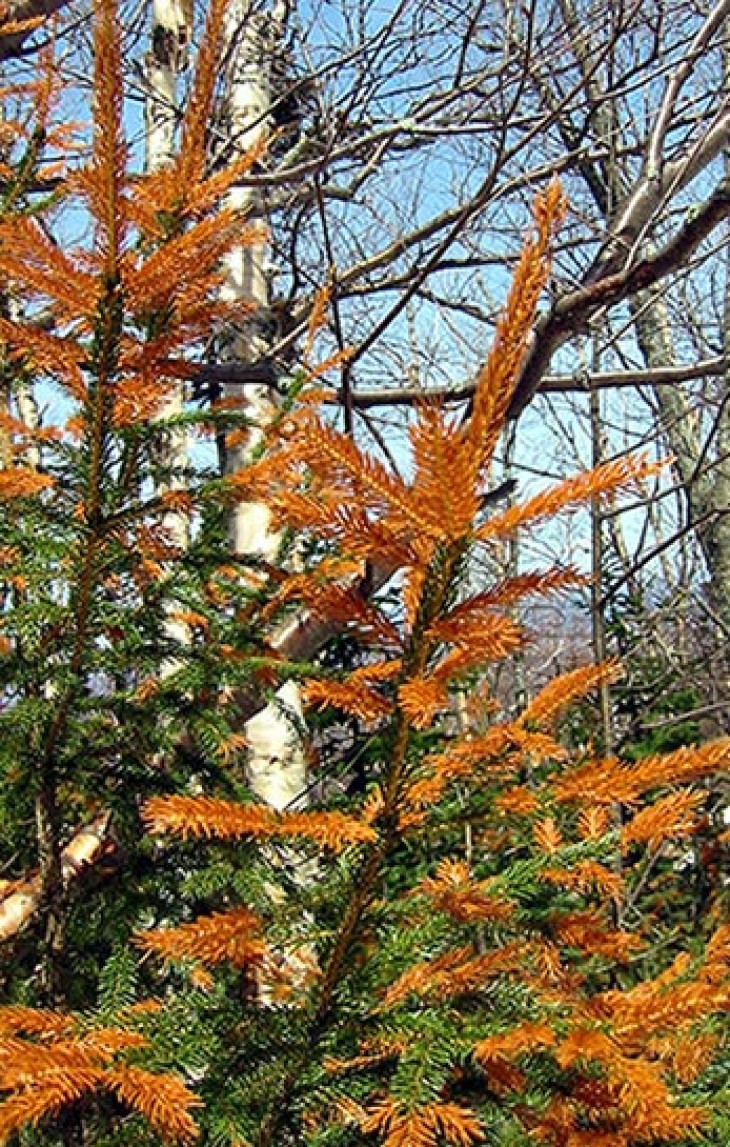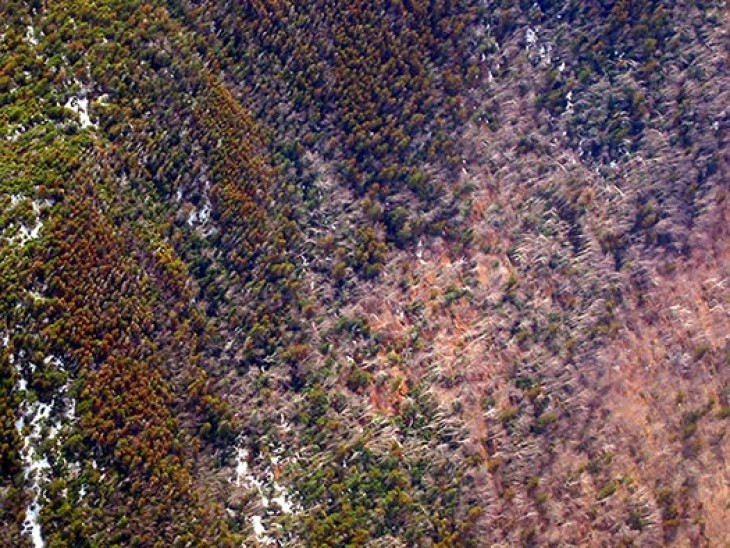Everyone loves a good comeback story – like Rocky Balboa coming out of retirement and willing his way to victory through sheer grit and determination. Or like Super Bowl champion Kurt Warner, the undrafted quarterback who was bagging groceries for $6 per hour when the NFL called. And, of course, chief of all great comeback stories: the 2004 Red Sox, who rallied from three games down against the Yankees to win eight straight and claim their first World Series title in nearly a century.
Recounting sports comeback stories is great, but even better is hearing a tale of resurrection from the biological world. Right here in New England, the red spruce, Picea rubens, a species thought by some to be headed toward inevitable demise, seems to be rebounding. Recently, researchers from the University of Vermont and the U.S. Forest Service measured the growth rates of 379 red spruce trees from Vermont, New Hampshire, and Massachusetts and found a surprising trend: not only were the trees not declining in growth as they’d expected, but they’re growing faster than they ever have in recorded history.
A Species in Trouble
This red spruce story goes back to the 1960s. As “Beatlemania” was invading the rest of the country, Hub Vogelmann, professor of botany at the University of Vermont and iconic conservationist, and graduate student Thomas Siccama were doing routine plant surveys on Camel’s Hump in the Green Mountains of Vermont. The work was to be part of Siccama’s doctoral research documenting plant communities and forest succession at differing elevations. After recording large numbers of high- elevation red spruce trees that were stressed and dying, they returned 15 years later and were shocked to discover that over half the trees had been lost.
At first, the cause of death was a mystery. The researchers could tell that natural stresses, particularly winter injury, had played a role, but it wasn’t clear why the trees died. Eventually, it became apparent that acid rain (discovered in the 1960s) was a contributing factor. Deposits of sulfur and nitrogen dioxide were causing calcium to be leached from the forest soils and the trees’ needles, compromising their tolerance to cold winters. In 1982, Vogelmann published an influential article in Natural History magazine called “Catastrophe on Camel’s Hump,” linking the spruce decline to air pollution.
Vogelmann and Siccama’s findings caused other scientists to take a closer look at the effects of acid rain and calcium deficiency on the forest ecosystem. In the years that followed, researchers considered other variables that were at play in the spruce decline, such as wind exposure, root damage, natural succession, and climate change, but acid rain remained the focal point. In 1990, federal lawmakers approved changes that bolstered the Clean Air Act as a direct result of the work done on Camel’s Hump and elsewhere in the Northeast.
As acid rain in the region gradually abated, newspaper headlines gave way to newer environmental crises du jour: deforestation in the rain forests of Brazil, old growth logging, the spotted owl controversy of the Pacific Northwest among them. Meanwhile, the solitary red spruces of the Northeast continued to suffer, whether or not the public was paying attention.
A Pleasant Surprise
Paul Schaberg was still paying attention. A plant physiologist for the U.S. Forest Service’s Northern Research Station, he remembers a watershed moment nearly 15 years ago: he was riding a Vermont ski lift, when rising over a crest and looking out over the landscape he noticed something strikingly wrong.
“I was aghast,” he says, recalling the hundreds of crimson red spruces punctuating the landscape. “It wasn’t until we got up high in the air that it hit me just how bad it was. It was really quite striking.”
That was in early 2003, at the tail end of a bone-chillingly cold winter. Frigid arctic air and stinging winds had zapped the new foliage of nearly every red spruce tree in sight. Up to that time, Schaberg had been tracking the condition of red spruces and researching the effects of acid rain, calcium deficiency, and repeated winter injury on tree health, but he’d never seen a sight as dramatic as this.
He moved quickly to encourage his colleagues to examine the extent and severity of the damage. The Vermont Department of Forests, Parks, and Recreation conducted an aerial survey of the damage, as did other neighboring states. Schaberg, along with his colleague at the University of Vermont, Gary Hawley, hastily lined up a master’s student to head out and quantify the amount of damage up close.
Brynne Lazarus visited 28 different sites around the region and came back with dramatic findings: 90 percent of all red spruces she looked at had incurred damage that winter. On average, trees lost nearly half of their new foliage and a third of their new buds. The damage was particularly bad on older, dominant trees at higher elevations, where the trees were more exposed.
Schaberg and his colleagues wondered what long-lasting effects such severe damage would have on the trees. They knew that repeated injury had weakened the trees’ immune systems and slowed their growth, contributing to the chronic decline, but how would this affect the trees’ carbon storage?
In 2010, Hawley and Schaberg assembled another team, this time led by graduate student Alexandra Kosiba, to measure just how much carbon sequestration had been lost by that massive winter injury event back in 2003. Kosiba took cores from nearly 400 red spruce trees around the region and examined their growth rings. What the team found along the way was in some ways more interesting than what they had originally set out to do.
“We did learn that there was at least a three-year reduction in growth following the harsh winter of ’03,” Schaberg told me, “and that it equated to almost 2.5 million tons of sacrificed CO2 sequestration…but what really stole the headlines was the upsurge in growth that the trees have been experiencing since then – they’re growing like crazy!” he exclaims.
The data show that the trees were growing at nearly twice the rate of the average red spruce recorded over the past century.
Searching For Answers
Have air quality regulations succeeded in squelching the effects of acid rain? Is climate change mitigating winter injury to the spruces? Are these long-lived trees just now hitting their prime? Is the same thing happening elsewhere in the natural range of red spruce, or just in New England? “Well,” Schaberg says, “that’s what we’re trying to figure out.”
As a scientist, he is hesitant to extrapolate beyond what the data are capable of telling us. As it turns out, the problems that plagued red spruce for so long are more complicated than they appeared.
“Through our annual monitoring programs, we’ve learned that there really needs to be a trifecta of conditions for the winter damage to occur,” Schaberg explained, after I asked him whether the brutal winter of 2014-2015 in the Northeast resulted in another major injury event. “First, there’s the acid rain issue as a prerequisite, having leached the calcium from soils and needles; second, the trees must be predisposed to stress by poor growing conditions in the previous year(s) – drought, excessive heat, a late frost…things that further set the stage, so to speak. And then, throw in a very harsh winter – and that’s when we really see the damage show up.” In other words, it needs to be a perfect storm.
Researchers in New England are now trying to tease apart the confounding variables that influence tree growth in order to find out what’s really behind the recent boom. Kosiba and others are taking a closer look at various weather- and climate-related metrics – particularly warmer winters and extended growing seasons – to see which, if any, correlate to the growth rates.
Others are taking advantage of new capabilities afforded by geographic information system (GIS) models and better data to estimate the acid pollution loading across the region and to compare it to the growth rates of specific trees.
Elsewhere, Schaberg says, researchers are undertaking studies to determine if other tree species that fill a similar niche – temperate conifers such as white pine and hemlock – are also growing better as of late. Perhaps whatever is driving red spruce is affecting other trees, as well.
Red Spruce Around The Region
In the White Mountains of New Hampshire, long-time U.S. Forest Service researcher Bill Leak and his colleagues have also been keeping an eye on red spruce at the Bartlett Experimental Forest. Rather than extracting tree cores and analyzing ring widths, they reviewed historic forest inventory data dating back to the 1930s to see how red spruce has fared over time. Data from 57 permanent sample plots at upper elevations (1,500-2,900 feet) originally measured in 1932 and remeasured in 1992 and again in 2003, were analyzed to see what changes have occurred. These are stands that have essentially been unmanaged during this period, providing a suitable reference condition with which to compare.
The findings show that red spruce is holding up remarkably well, in spite of acid rain, climate change, and the other maladies facing them.
“The data show that overstory red spruce (five inches DBH and larger) have maintained their dominance and even gained ground over other species during the past 70 years. They seem to be doing just fine here,” Leak says matter-of-factly. Even more promising is that it appears that there is an ample supply of red spruce in the understory to sustain the species into the future.
These results suggest that perhaps the mortality and decline experienced in some parts of New England has not been universally felt, or that maybe they were temporary and are coming to an end.
Another confounding plot twist, according to Schaberg and Leak, is that red spruce in Canada (where the natural range of red spruce is double the acreage it occupies in the U.S.) never seems to have experienced the decline that occurred here beginning in the 1960s. “Up there, red spruce has been, and continues to be, an important commercial species with high rates of harvest, reforestation, active management, and even genetic improvement programs,” Schaberg said. It’s conceivable to think of our neighbors to the north reading this article and wondering what all the fuss is about.
The Importance of Red Spruce
Schaberg considers red spruce a keystone species, implying that ecologists place an above-average importance on its role in holding the ecosystem together. It provides crucial habitat for the northern flying squirrel, a relic of the last ice age with a strong fidelity to the cool, moist environs of high-elevation spruce-fir woodlands. Red spruce is prized as a lumber tree: it is strong, lightweight, and straight-grained. It’s also easily worked, and instrument makers consider it a premiere species for its acoustic qualities in violins and other string instruments.
The red spruces that we have left today are but a fraction of those that were once here, having survived the axes of early settlers and the acid rains of Hub Vogelmann’s time. Historic milling records in Vermont indicate an abundance of red spruce logs passing through as vast swaths of virgin forest were cut and converted to farms and pastures. The survivors that have outlived harsh winters like 2003 – what Schaberg calls “selection events” – are essentially the fittest of the fit.
Schaberg is excited by the recent discovery that red spruce is rebounding, both because of what it means for that species and because of its potential to help us learn more about the overall dynamics of forest health. “I’m always happy to talk to anyone I can to spread the message and tell them the story of red spruce,” he says. “It’s great to have this renewed interest in the species, because it means people are paying attention to the forest as a whole, and the benefits that we all derive from it.”
Now, if only he could work some comeback magic into the sports world – because I know there are plenty of Red Sox fans who are hoping for a similar revival to take place at this year’s spring training.






Discussion *